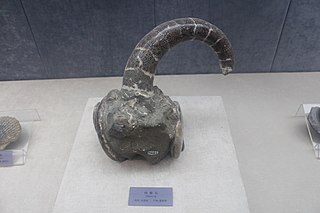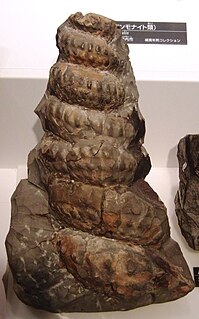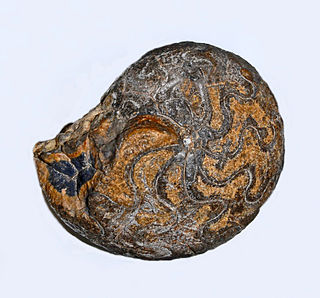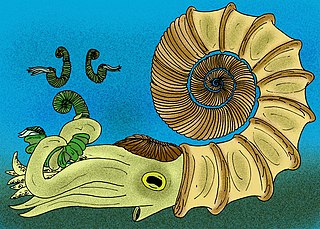 W
WAcanthoceras is an extinct cephalopod genus belonging to the subclass Ammonoidea and family Acanthoceratidae that lived from the Albian to early Coniacian stages of the Cretaceous.
 W
WAconeceras is an early Cretaceous ammonite included in the oppeliid subfamily Aconeceratidae, characterized by an involute, high-whorled, flat-sided shell that bears a finely serrate keel along the venter. Sutures have narrower and deeper elements than in Protaconeceras. Aconeceras has been found in western Europe, South Africa, and eastern Australia. Its stratigraphic range is from the Upper Barramian to the Lower Albian.
 W
WBeloceras is a genus of ammonites included in the family Beloceratidae. These fast-moving nektonic carnivores lived in the Late Devonian period, from 379.5 to 376.1 Ma.
 W
WClymenia is a genus in the ammonoid order Clymeniida, restricted to the Upper Devonian, characterized as with all clymeniids by a dorsal siphuncle that runs along the inside of the whorls, unusual for ammonoids.
 W
WGaudryceras is an ammonite genus belonging to the family Gaudryceratidae.
 W
WHamites ("hook-like") is a genus of heteromorph ammonite that evolved late in the Aptian stage of the Early Cretaceous and lasted into the Cenomanian stage of the Late Cretaceous. The genus is almost certainly paraphyletic but remains in wide use as a "catch all" for heteromorph ammonites of the superfamily Turrilitoidea that do not neatly fit into the more derived groupings. In an attempt to identify clades within the genus, it has been divided up into a series of new genera or subgenera by different palaeontologists, including Eohamites, Hamitella, Helicohamites, Lytohamites, Planohamites, Psilohamites, and Sziveshamites.
 W
WKossmaticeras is an extinct ammonoid genus belonging to the desmoceratacean family Kossmaticeratidae. Species in this genus were fast-moving nektonic carnivores. They lived during the Late Cretaceous, from upper Turonian to upper Maastrichtian age. The type species of the genus is Ammonites theobaldianus.
 W
WManticoceras is a genus of ammonites included in the family Gephuroceratidae. These fast-moving nektonic carnivores lived in the Devonian period, from 382.4 to 376.1 Ma.
 W
WMariella is an ammonoid genus, named by Nowak (1916) from the upper Albian and Cenomanian stages of the mid Cretaceous, included in the Turrilitidae. Its type is Turrilites bergeri
 W
WMonophyllites is an extinct cephalopod genus belonging to the family Ussuritidae that lived during the Triassic period, from Anisian to Ladinian age.
 W
WNostoceras is an extinct genus of ammonites. The etymology of the name Nostoceras comes from "nostos" meaning return and "ceros" meaning horn, named as such by Alpheus Hyatt because it bends back on itself.
 W
WPachydiscus is an extinct genus of ammonite from the Late Cretaceous with a worldwide distribution, and type for the desmoceratacean family Pachydiscidae. The genus' type species is P. neubergicus. Altogether some 28 species have been described.
 W
WPlatyclymenia is a genus of ammonites belonging to the family Platyclymeniidae.
 W
WTropaeum ("Trophy") is an extinct genus of ammonites found throughout the oceans of the world during the Early Cretaceous. As with many other members of the family Ancyloceratidae, there was a trend among species within this genus to uncoil somewhat, in a very similar manner to the genus Lytoceras. The largest species, T. imperator of Australia, had a shell a little over one meter in diameter.
 W
WTurrilites is a genus of helically coiled ammonoid cephalopods from the lower part of the Upper Cretaceous ; generally included in the Ancyloceratina. Previously it was included in the ammonoid suborder, Lytoceratina.